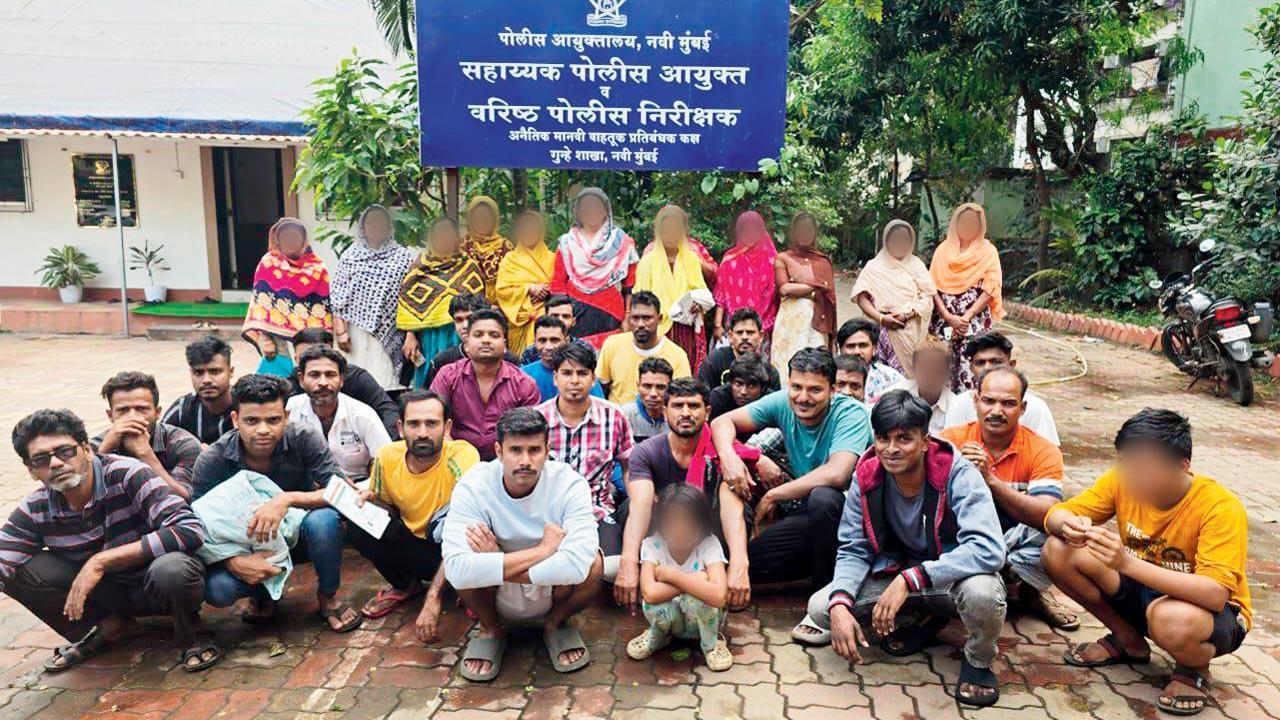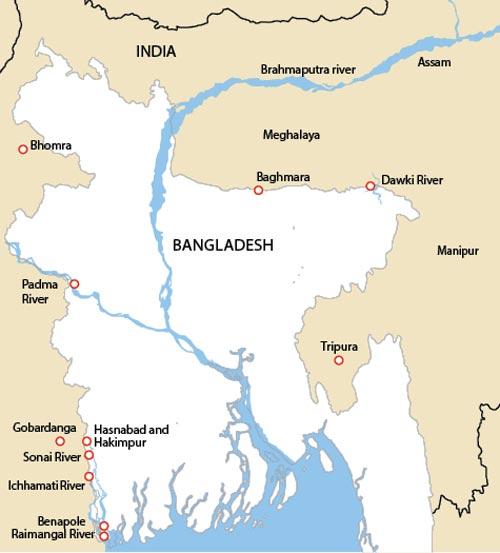As cops begin process of deportations, mid-day explores the routes most commonly used by illegal immigrants

Illegal Bangladeshi immigrants who were caught by the Navi Mumbai Anti-Terrorism Squad in the last week of 2024
In the last 45 days, Mumbai police managed to arrest 299 Bangladeshi citizens residing in the city illegally—the highest number recorded so far, as compared to 150-160 illegal immigrants nabbed by the police annually. The drive against illegal Bangladeshi militants that began last year has drastically intensified this year. The police are now in the process of deporting those arrested.
ADVERTISEMENT
As per the data, the land borders stretching approximately 4096.7 km along West Bengal (2216.7 km), Assam (263 km), Meghalaya (443 km), Tripura (856 km) and Mizoram (318 km) are surrounded by hills, mountains and rivers.
Interrogation of those arrested revealed that since most of the land borders are guarded by the BSF jawans, they are increasingly using the river routes to enter Indian territories.
There are around 54 rivers along the India-Bangladesh border across five states: West Bengal, Assam, Meghalaya, Tripura and Mizoram. The police said that the rivers are increasingly becoming the safest routes for immigrants to cross the borders.
“In the recent Saif Ali Khan attack case, the assailant who is a Bangladeshi national reached India by crossing the Dawki River. He entered Meghalaya after crossing the border and from there he reached Mumbai in search of a job,” an officer from Bandra police station said on the condition of anonymity.
According to the Bangladeshi nationals, they found that some of the rivers along the India-Bangladesh border go dry during the summer months making it easy for them to cross. They even take advantage of low visibility due to fog during winter to cross the border.
Rivers used for illegal entry
Padma River: The river begins in India at the junction of the Ganges and Jamuna Rivers and ends in Bangladesh. At the border, where the Padma River starts, the water level becomes low and slow. During summer, the river dries up. Many Bangladeshis arrested by Mumbai police have revealed details about this route.
Dawki River: Also known as the Umngot River, it is a famous river in Meghalaya, known for its crystal-clear water, making it a popular boating destination. This route from Bangladesh to India is hardly 200 metres long. Shariful Islam, who attacked Saif Ali Khan, entered India via this route.
Sonai River: Located in Assam and Mizoram, the river is less than 100 metres wide and narrows further in some areas. The Sonai River, along the West Bengal border, poses a major security threat as it is frequently used for human trafficking from Bangladesh to India, and often by smugglers. However, seasonal challenges such as heavy rains, fog, and winter conditions make crossing difficult.
Ichhamati River: Located near the Benapole border in West Bengal, the river is not more than 100 metres wide and is frequently used by Bangladeshi citizens to enter India. Many boats operate in this area, facilitating illegal migration with the help of agents. According to sources, this border is also used for smuggling food, medicines, and drugs.
Raimangal River: The river, bordering West Bengal also located at the Benapole border, is another commonly used route. It is not more than 150 metres wide at the border. However, it is deep with a strong current, making it difficult to cross. During summer, many Bangladeshis use this river to enter India illegally.
Road and forest routes used
Bhomra: Bhomra Land Port in West Bengal is a trade route between India and Bangladesh. However, it is also used for human trafficking. Bangladeshi migrants pay agents around Rs 30,000 to be smuggled into India and vice versa.
Baghmara: This is a difficult route that involves crossing 150 km of dense forest. Bangladeshi nationals cross on foot from Durgapur (Bangladesh) to Baghmara in Meghalaya. Once in India, they are transported to Krishnai and New Bongaigaon railway stations in Assam.
The Radcliffe Line: Tripura shares an 856-km-long border with Bangladesh. Known as the Radcliffe Line, it is the fifth-longest land border in the world. Some sections are fenced on both sides, but other parts remain vulnerable. Many Bangladeshis take advantage of the darkness to cross into India illegally in pursuit of a better life.
Hasnabad and Hakimpur: Hakimpur and Hasnabad are villages in West Bengal's North 24 Parganas district, located along the India-Bangladesh border. The border here consists of a narrow water body, less than 50 metres wide. Every day, many Indians cross into Bangladesh for farming and return by 2 pm, and vice versa. Cattle are also smuggled through this route. Bangladeshi citizens consider this one of the safest routes to cross the border illegally with the help of agents.
Gobardanga: The Gobardanga border is another favoured crossing point along the West Bengal border. Many enter India illegally by slipping under the border fencing. Jhaudanga village in Bangladesh is a key entry point where migrants use gaps in the fencing to cross.
Benapole-Petrapole Border: Many Bangladeshi nationals arrested in Mumbai have admitted to entering India through the Benapole border in Kolkata, which is an international crossing point between India and Bangladesh, also known as the Petrapole Crossing. While this route is primarily used for trade, many Bangladeshis use it for smuggling and illegal entry through fencing gaps and small river routes. Police sources indicate that many agents are active in this region.
CopSpeak
Speaking with mid-day, Joint Commissioner of Police (Law and Order), Satyanarayan Chaudhary said, “In the last 45 days, we have arrested 299 Bangladeshi citizens—the highest number recorded so far. In previous years, we arrested around 150-160 Bangladeshi citizens who were living illegally in India.
Most of these accused entered the country through various border routes. We have also instructed all police stations in Mumbai to take strict action against illegal Bangladeshi immigrants residing without valid passports and visas.”
Chaudhary added, “We have a special I-Branch of Special Branch-1 that is actively deporting illegal immigrants to their respective countries—including Pakistan and Bangladesh. We are also working with Aadhaar and PAN card centres to verify documents, as many Bangladeshi citizens create fake documents to claim Indian citizenship.”
299
No. of illegal Bangla immigrants nabbed in 45 days

Graphic/Yogesh Jain
 Subscribe today by clicking the link and stay updated with the latest news!" Click here!
Subscribe today by clicking the link and stay updated with the latest news!" Click here!







